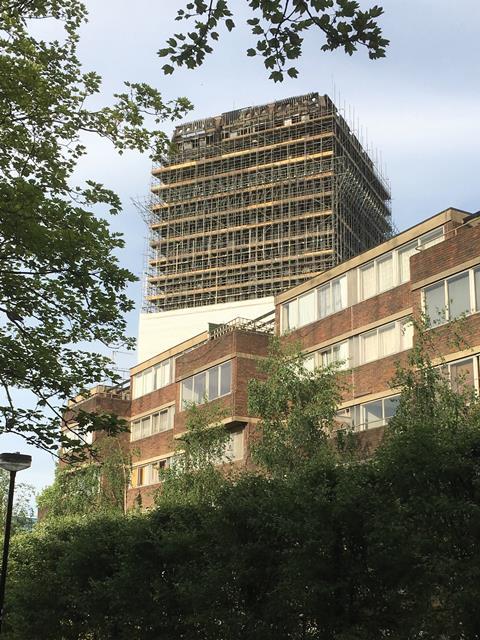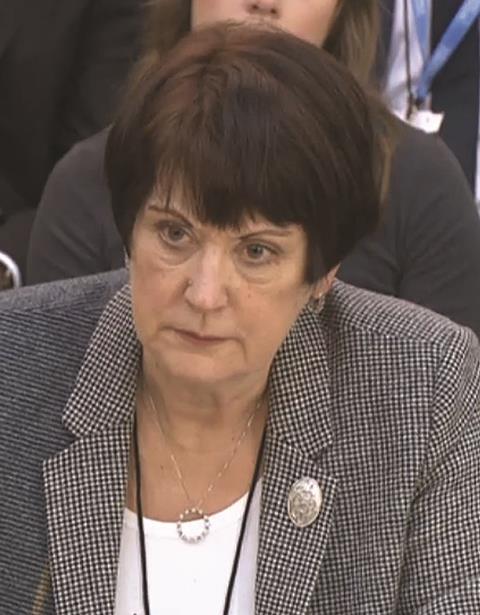Dame Judith Hackitt’s report into building regulations and fire safety blames a broken system that needs fixing. So far, so uncontroversial. But her prescription for change has caused uproar right across the industry. Joey Gardiner examines the guts of the report and asks if its proposals are likely to go anywhere

Within 20 minutes of Dame Judith Hackitt’s 156-page report into building regulations and fire safety being released, Tottenham MP David Lammy – a personal friend of Grenfell Tower victim Khadija Saye – had already branded it a betrayal and a whitewash. Shortly after, survivors group Grenfell United professed itself to be “saddened and disappointed”.
Hackitt can hardly be surprised at the response. Because, while the report contains many widely supported recommendations for improving the system, it is at heart guided by a profoundly controversial conclusion: that the tragic blaze was a result of building regulations being too prescriptive, not too lax.
Hackitt has come to her conclusion given years of experience in the chemicals and oil and gas industries, which she says have successfully followed a model where it is the organisations that create risk, rather than the government, that set the rules. Hence she recommends handing control of creating building regulation guidance to the construction industry, an industry she herself admitted in January has a “mindset of doing things as cheaply as possible and passing on responsibility for problems and shortcomings to others”.
But for those arguing for more prescription, this simply adds insult to injury. And it is not only social housing residents who are worried. Many in the construction industry itself are voicing doubts as to whether it is capable of stepping up to the plate, and what kind of outcome it will create. Meanwhile there are huge concerns over what on earth the owners of unsafe tower blocks should do now to make blocks safer.
Responsibility
Launching her report last week, Dame Judith made clear her recommended approach was one that had worked in other sectors. Her vision is that less prescriptive building regulations would sit within a beefed-up regulatory process for high-rise housing, new systems for ensuring individual professional competence, and much tougher sanctions – including imprisonment – for those that flout the rules. All of which, in her view, will force the industry to take proper responsibility for fire safety as an issue, rather than attempt to push the guidance as far as it will go. Hackitt says: “No longer can the building industry look to others to tell them what is and is not acceptable. Those undertaking building work must recognise their fundamental responsibility to provide a safe building, not just comply with rules.”
She adds: “It’s regrettable that perpetual governments have fallen in to this trap of continuing to provide more and more prescription rather than facing up to a forcing the industry to take responsibility.”
Andrew Lancaster, construction partner in law firm Anthony Collins, says: “The idea behind it is admirable. Her point is that construction is so complex it’s not possible to regulate with a rules-based system for every eventuality. In principle the idea of moving to outcomes-based regulation is very good.”
However, whether it is practically achievable is another question. Hackitt said at the report launch: “I know that delivering such a culture change will be challenging, but I also know that it can be done.” But others doubt it.
Lancaster says: “In theory she’s right but in practice she could be wrong. This is going to be really difficult for the sector.”

No changes to guidance
This is because, consistent with her conclusion, her report included no specific recommendations for changes to building regulations or building regulations guidance, which meant ignoring the issues seen by many to be at the heart of the failure at Grenfell: what standards should cladding and insulation panels be held to? How many means of escape should a tower block have? When must it have sprinklers? Should these be retrofitted?
Amid the controversy over the report, communities secretary James Brokenshire did quickly announce the department was considering banning combustible cladding, seen by campaigners as Hackitt’s most egregious omission. But this concession to public concern didn’t change the overall direction of travel indicated.
The most immediate problem posed by the report is faced by those landlords who own tower blocks with similar cladding systems to Grenfell, and who had been hoping for clarity on what to do next to best reassure their tenants. Lord Porter, chairman of the Local Government Association, immediately branded the report a disappointment, and said only a ban on combustible cladding panels “would provide the clarity for building owners who need to know what they can use to replace dangerous cladding and insulation and immediately help keep buildings safer”.
As of last month just seven of the 158 social housing tower blocks identified as having unsafe cladding systems had completed improvement work, with landlords citing both funding and lack of a clear regulatory steer as an issue. The chief executive of one social landlord responsible for more than 20,000 homes said of the report: “This has simply handed the problem back to us to sort out. There’s no clear guidance, and it’s not clear what we should replace unsafe cladding with.”
Hackitt’s report also gave no indication as to how long the transition to the new system will take. Adrian Dobson, executive director for members at the RIBA, says: “The industry doesn’t know what to do, and people living in the buildings don’t feel safe. You’ve got to provide more clarity but this is yet more mush.”
Hackitt’s proposed Building Regs changes
How do Building Regs work now?
The UK already has an “outcomes-based” system of building regulation. In law, the Building Regulations consist of simply a short series of brief “functional requirements” covering different elements of a building, such as structure, energy efficiency and fire safety. Much of what is commonly referred to as Building Regulations is in fact the lengthy guidance, contained in government-authored “approved documents”, which sits beneath that. It is not supposed to be prescriptive, but instead is meant to offer examples of how the functional requirements can be met.
Hackitt’s conclusion is that the original intent of the UK’s outcomes-based system of building regulation has been lost over time, and that the complex and overlapping guidance has become increasingly seen as prescription that must be followed.
However, a number of those who submitted evidence to the review said that more, not less prescription was required to avoid another tragedy like Grenfell.
What is being proposed?
Hackitt’s report says that “prescriptive regulation and guidance are not helpful in designing and building complex buildings […] and will prevent those undertaking building work from taking responsibility for their actions. An outcomes-based framework requires people who are part of the system to be competent, [and] to think for themselves rather than blindly following guidance”.
Hence, the report finds the government should simply “set outcomes to be achieved”, while industry must respond “by shaping detailed guidance to support the delivery of those outcomes”. In practice,
it says, a new body or “structure” will have to be set up to provide “validation and assurance of industry guidance” – essentially assessing it and giving an official stamp of approval where appropriate. This body will replace BRAC, the panel which advises government on writing Building Regulations guidance and will be directed by the new regulator Hackitt proposes, the Joint Competent Authority. The government will retain an ability to write guidance only where industry is deemed unable to produce it.
Asked at the launch of her report why she was trusting the construction industry with this task, Hackitt said: “I’m not trusting them. They have to earn that trust. What the recommendations says is we will transition to a position where they own their own guidance, but that that whole process will continue to be overseen by the JCA.
“That doesn’t imply that we’re leaving them to make up their own rules, that means they will have to meet the standard that is required of them.”

Missed opportunity
It is not only the length of time it will take to implement Hackitt’s recommendations that is concerning people, but also the direction of travel itself. One industry expert said it “beggared belief” that the response to such a horrific tragedy could end up being the relaxing of rules.
RIBA’s Dobson says: “It feels like she’s lost common sense, with conclusions wrapped up in the kind of pseudo-science that are part of what got us into this problem.” Ben Jayes, managing director of materials reseller Vivalda Group, says he feels “let down” by a review he had hoped would ban combustible material on tall buildings. “This all feels too weak to effect the major culture change that’s needed in the construction industry,” he says.
Not content with a general move away from prescription, Hackitt also concluded her new system should only apply to buildings of 10 storeys or higher – equivalent to around 30m – which is much higher than the 6-storey (18m) height at which many existing provisions designed to protect tall buildings kick in today. Former RIBA president Jane Duncan says the decision to focus on just a small number of the tallest buildings was “a major missed opportunity”, while others called for the inclusion of lower and non-residential buildings.
There doesn’t appear to be any great clamour from industry for this relaxation in government guidance either. Steve Cooper, a director at fire engineering firm Tenos, says that as an experienced fire engineer he could himself very happily work without guidance, but that he is worried whether the industry as a whole could effectively manage that complexity, particularly given it is already facing a shortage of experienced fire engineers. “It’d be an engineers’ charter,” he says. “You’d need a fire engineer for every building – there wouldn’t be enough to do the work. As you take away prescription, you increase the need for more skills.”
RIBA’s Dobson says: “You can see how Hackitt’s approach could work on high-end projects like the new Bloomberg building with star-architects. But a lot that will fall under this will be mid-range projects, often done on a commercial basis by ordinary architects and engineers doing their best job on a budget. We think they need some baseline prescription.”
Simple guidance, of course, is as helpful to those in building control that sign off plans as to buildings’ designers. Hence, in a world with less prescriptive guidance, the skills question is as relevant – if not more so – for building control officers. “If this requires industry to issue its own guidance itself, it’s going to require an experienced regulator to hold industry to account. If that’s not there, the system will be weaker than today,” says Anthony Collins’ Lancaster.
Hackitt on…
Blame:
“It’s regrettable that perpetual governments have fallen into this trap of continuing to provide more and more prescription rather than facing up to forcing the industry to take responsibility.”
Cladding:
“What I’d be very disappointed about is if people think that simply banning cladding will fix this problem. It won’t. It is a broken system.”
Guidance:
“The guidance needs to be restructured so it is not so prescriptive, but it is also clear and non-contradictory.”
Culture change:
“This already works in other sectors and I know it can be achieved. It is time for this industry sector to step up to its responsibilities. I call on industry leaders to start working with government and start delivering these reforms now.
“I know that delivering such a culture change will be challenging, but I also know that it can be done […] It is a big shift, but it is not a leap into the unknown.”
Grenfell Tower:
“I’m not an expert on Grenfell.”
Risk dumping
Hackitt says current Building Regulations guidance is confusing for the industry, written in silos and containing contradictory statements that make implementation impossible. Few would disagree. But it isn’t clear how letting industry write guidance would necessarily improve this. Tenos’ Cooper says: “The industry is massive, with a huge range of bodies each with their own agenda. You’d end up with a 500-page document trying to be everything to every person, and that’s not necessarily the best guidance. It’ll be guidance that suits the agenda of the people willing to spend time to get involved.”
The RIBA’s Dobson adds: “Hackitt makes the analogy with the chemical industry and the car industry – but there you have sectors dominated by a relatively contained number of key players with defined supply chains.
“The construction industry is totally different, with a structure based on risk dumping on to the smallest contractors,” he says, adding that taking on responsibility for its own guidance appeared to presume a big culture change that had not yet happened.
But Hackitt rejects any suggestion an unreformed construction industry might undermine her system, saying any new guidance will have to be “approved and signed off by the regulator” and that the industry “will have to earn that trust”.
With the government looking increasingly likely to ban combustible cladding despite Hackitt’s conclusions, landlords and residents may get some clarity in the medium term. Brokenshire’s guarded welcome for Hackitt’s report, in which he promised more detail on how it will be taken forward in the autumn, suggested he is still to decide whether to take the leap of faith required to adopt Hackitt’s proposals in full.



























No comments yet